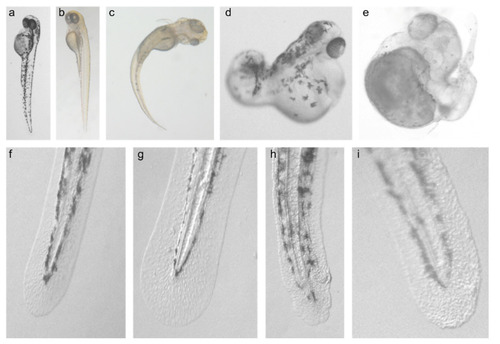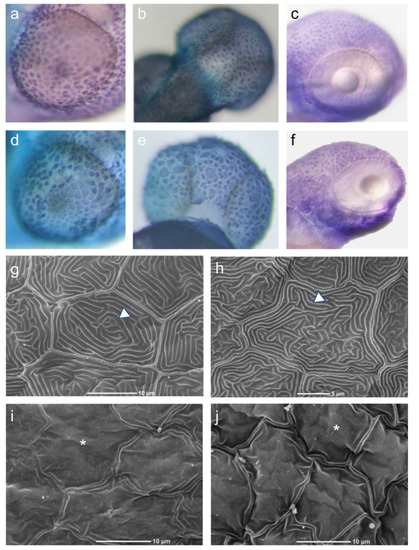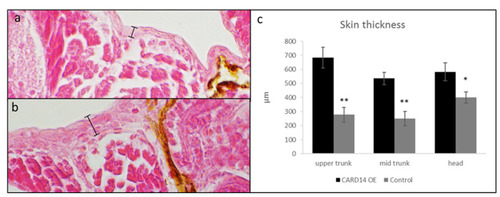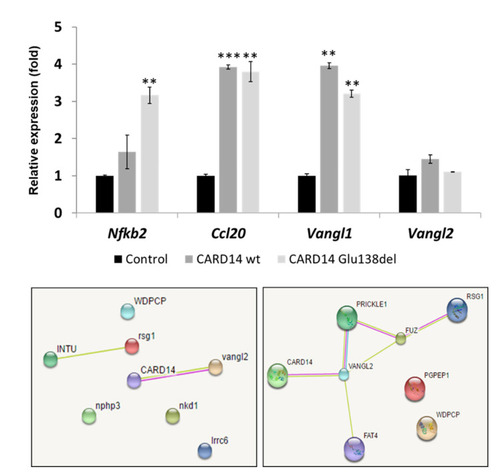- Title
-
Cutaneous and Developmental Effects of CARD14 Overexpression in Zebrafish
- Authors
- Baniel, A., Ziv, L., Ben-Moshe, Z., Sarig, O., Mohamad, J., Peled, A., Rechavi, G., Gothilf, Y., Sprecher, E.
- Source
- Full text @ Biomedicines
|
Developmental and cutaneous effects of Card14 overexpression. Three days post-fertilization (dpf) uninjected (a) and gfp-RNA (b) injected larvae as compared to larvae injected with zfCard14 RNA (c–e). The latter demonstrating a wide range of disturbed caudal development. Note asymmetric eye development in (c,e). Smooth surface, regular border and uniform pigmentation are seen in uninjected (f) and gfp-RNA injected (g) larvae; in contrast, irregular borders, spiky pigment and a “granular” surface are seen in larva injected with zfcard14 (h) and hcard14 (i) RNA. |
|
Keratinocyte morphology. Upper panel: Whole mount in situ hybridization with a probe recognizing cytokeratin1 mRNA (dark stain) at 2 dpf (a,c,d,f) and 3 dpf (b,e) demonstrating the distribution and morphology of keratinocytes over the eye (a,d) and over the head (b,c,e–f) areas. Control larvae were injected with an empty plasmid (b) or gfpRNA (a,c), and compared to larvae injected with hCARD14 (e) or zfcard14 (d,f). Note in both regions the uneven distribution and size as well as cell cluster formation as a consequence of CARD14 overexpression as opposed to the even size and regular borders of control keratinocytes. Lower panel: Scanning electron microscopy of 2 dpf embryos. Uninjected (g) and gfp-RNA injected (h) embryos display a uniform and complete array of microridges (triangle), and smooth cell surface, while zfcard14 (i) and hCARD14 injected (j) embryos display uneven cell surface topography (asterisk). |
|
Histopathology at 3 dpf. H&E staining ×40 magnification. Skin of control larvae (a) injected with zfcard14-RNA containing a stop codon display a thinner epidermis than larvae injected with zfcard14-RNA (b). Graph (c) shows average of 6 measurements at 3 different anatomical sites: head at superior edge of eyes, superior and mid trunk (two-sided t-test; * p < 0.05, ** p < 0.01). |
|
Effect of CARD14 overexpression on gene expression. Embryos were injected with expression vectors carrying human wild type and PRP-causing CARD14 mutation (p.Glu138del). Relative expression of nfkb2, ccl20b, vangl1 and vangl2 was ascertained 1 dpf using qPCR (upper panel). Results represent the mean of 3 replicates and are provided as gene expression relative to gene expression in control embryos ± standard error normalized to ppiab mRNA levels (two-sided t-test; ** p < 0.01, *** p < 0.001). Protein interaction (STRING, http://string-db.org, accessed on 17 May 2019) analysis of CARD14 and planar cell polarity proteins in zebrafish (left lower panel) and human (right lower panel) is predictive of a functional interaction between CARD14 and VANGL2. |




